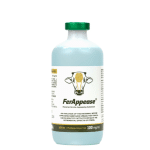Why UK Farmers Must Stay Alert This Autumn
After an unusually dry summer followed by initial heavy autumn rainfall across the UK, livestock farmers are facing a dangerous surge in cases of perennial ryegrass staggers. This neurological disorder can severely affect cattle, sheep, horses, and camelids, leading to reduced productivity, distress, and even death.
The condition is often overlooked until symptoms become severe, making early detection and prevention absolutely critical. With climate patterns becoming more erratic, the risk is expected to rise in future seasons, and we want to ensure that our clients are best posed to mitigate any risks.
Carry on reading to learn how to detect, treat, and mitigate against Perennial Ryegrass Staggers to ensure the safety of your stock.
-
The Hidden Cause: Toxic Fungi in Ryegrass
Perennial ryegrass staggers is caused by mycotoxins, particularly lolitrem B, produced by endophytic fungi such as Neotyphodium lolii. These fungi live inside Lolium perenne (perennial ryegrass) and are generally beneficial to the plant, improving drought resistance and pest tolerance.
However, when animals graze on infected ryegrass—especially the lower stems and seed heads—they ingest these toxins. The highest concentrations occur in late summer and autumn, particularly after drought followed by rain, which stresses the plant and increases fungal activity.
-
Symptoms Can Be Sudden and Severe
Animals typically show signs 2–3 days after ingesting toxic forage. Symptoms vary in severity and can escalate quickly:
- Muscle tremors and head nodding
- Stiff or uncoordinated gait
- Weakness or collapse
- Heat stress (panting, drooling)
- Reduced feed intake and productivity
- In extreme cases, death due to heat stroke or misadventure
These symptoms are often mistaken for other conditions, so it’s vital to consider pasture history and environmental factors when assessing livestock health.
-
Diagnosis Requires Fast Action
How to Confirm Ryegrass Staggers:
- Observe clinical signs and recent grazing history
- Rule out other neurological or metabolic disorders
- Conduct laboratory testing of pasture for lolitrem B to confirm exposure, we can help advise on this
Treatment Steps:
- Remove animals immediately from affected pasture
- Minimise stress: Handle animals quietly, provide shade, avoid loud noises or dogs
- Provide clean water and safe feed
- Contact Severn Edge Farm Vets for support of severely affected animals
Most animals recover within a few days once exposure stops, but severe cases may take weeks and require ongoing care.
-
Prevention Is Possible with Smart Pasture Management
Preventing perennial ryegrass staggers is far more effective than treating it. Here are proven strategies to reduce risk:
- Diversify pastures: Mix ryegrass with legumes and other grasses to dilute toxin intake
- Avoid overgrazing: This prevents animals from consuming the most toxic parts of the plant
- Harvest early: Cut hay or silage before flowering to reduce mycotoxin levels
- Use novel endophyte varieties: These strains offer plant resilience without producing harmful toxins like lolitrem B
- Monitor pasture conditions: Regularly inspect for signs of stress, fungal growth, and seed head development
We also advise that you consider rotational grazing and forage testing, especially during high-risk periods.
-
Climate Variability Is Increasing the Risk
With climate variability increasing the frequency of drought-then-rain cycles, the conditions that favour mycotoxin production are becoming more common. This means ryegrass staggers may no longer be a rare occurrence—but a seasonal threat.
As weather patterns shift, farmers must adapt their pasture management and animal health monitoring strategies to stay ahead of emerging risks.
Take Action Now: Protect Your Livestock
It is important that you monitor stock closely for any of the signs – early detection is key! If you suspect symptoms or want to test your pasture, call us on 01746 713911 for expert support and guidance.
Early intervention can save lives and prevent long-term productivity losses.





